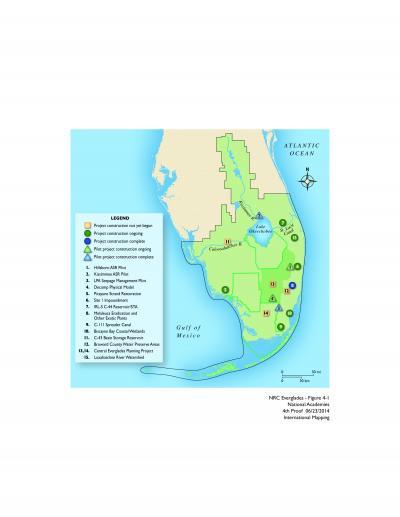WASHINGTON – Although planning for Everglades restoration projects has advanced considerably over the past two years, financial, procedural, and policy constraints have impeded project implementation, says a new congressionally mandated report from the National Research Council. Timely authorization, adequate funding levels, and creative policy and implementation strategies are needed to achieve restoration benefits and to expedite implementation of the Central Everglades Planning Project. Climate change and the invasion of nonnative plant and animal species further challenge the Everglades system. The impacts of climate change -- especially sea-level rise -- provide a stimulus to accelerate restoration efforts, the report adds.
The report is the fifth in a series of biennial evaluations of the Comprehensive Everglades Restoration Plan (CERP), a multibillion dollar project launched in 2000 with the goal of reversing the ecosystem's decline and creating a water system that simultaneously serves the natural, urban, and agricultural needs of southern Florida.
According to the report, restoration progress to date has been modest and focused along the edges of the ecosystem. The Central Everglades Planning Project, initiated in October 2011, recommends a suite of projects that would provide substantial new water flow to the central Everglades, equivalent to approximately two-thirds of the new water envisioned in CERP. The committee that wrote the report urged CERP planners and policymakers to find solutions to expedite the project's implementation in order to avert further degradation of the ecosystem's core. Without such solutions, water redistribution may not be feasible until 2035 or later, and with the envisioned funding level of $100 million per year, construction would not be completed for approximately four decades.
The report found that the infrequency of Water Resources Development Acts (the congressional mechanism for authorizing CERP projects exceeding $25 million), the availability of funding, and cost-sharing challenges have impeded CERP progress over the past two years. The Water Resources and Reform Development Act of 2014 – the first authorization in seven years -- enabled four additional CERP projects to proceed with federal funding, although the Central Everglades Planning Project was not completed in time to be included in the legislation.
The Integrated Delivery Schedule, which lays out construction plans for the next decade, needs to be revisited to incorporate the newly authorized projects and the Central Everglades Planning Project with existing restoration efforts, the report says. Given limited funding, all projects cannot be advanced equally, and planners should consider factors such as possible climate change and sea-level rise to determine which projects have the greatest potential for restoration benefits.

This map shows locations of CERP and CERP-related restoration and pilot projects.
(Photo Credit: National Academy of Sciences)
Sea-level rise has already increased saltwater intrusion into Everglades freshwater habitats and urban water supplies, and potential future changes in temperature and precipitation may affect the timing, volume, and quality of freshwater and the distribution of species, as well as increase agricultural water demands. Although they pose a challenge to restoration efforts, climate change and sea-level rise are reasons to accelerate restoration to enhance the ecosystem's ability to adapt to future changes. For example, improvements in water depths could promote the accumulation of peat in Everglades wetlands, reducing coastal wetland loss caused by sea-level rise.
The report recommends that climate change be incorporated into adaptive management planning at both the project scale and in systemwide goals, and that planners build flexibility into the design so new knowledge and improved climate change projections can be incorporated as they become available and future restoration efforts can be adjusted appropriately.
The report also states that planners should consider the implications of restoration activities on nonnative species. Invasive plants and animals displace native species and disrupt ecosystem structure and function, and some projects may affect the extent and abundance of nonnative species. The committee found that although there has been good coordination of invasive species management at the project level, strategic coordination over management and research priorities is lacking.
Setting effective priorities for managing invasive species requires a comprehensive understanding of all nonnative species present in the Everglades and their impacts and threats, as well as those of impending or possible new arrivals. Research is needed to determine which species could reasonably be predicted to have considerable ecological impacts. A strategic early detection and rapid response system that addresses all areas, habitats, and species is needed, the report states.
Scientific research provides the knowledge and tools that can help decision makers ensure that the resources invested in Everglades restoration are used wisely. Long-term monitoring collects useful information for understanding how projects are changing ecosystem conditions. A comprehensive re-evaluation of restoration-related monitoring is needed to determine its adequacy considering budget pressures, extended implementation time frames, and potential impacts of climate change and sea-level rise. In addition, renewed attention to science coordination and communication is needed, which includes adequate funding, staff, and a clear charge to address scientific priorities for restoration.
The study was sponsored by the U.S. Army Corps of Engineers, U.S. Department of the Interior, and South Florida Water Management District. The National Academy of Sciences, National Academy of Engineering, Institute of Medicine, and National Research Council make up the National Academies. They are private, independent nonprofit institutions that provide science, technology, and health policy advice under a congressional charter granted to NAS in 1863. The National Research Council is the principal operating arm of the National Academy of Sciences and the National Academy of Engineering. For more information, visit http://national-academies.org. A committee roster follows.
Source: National Academy of Sciences